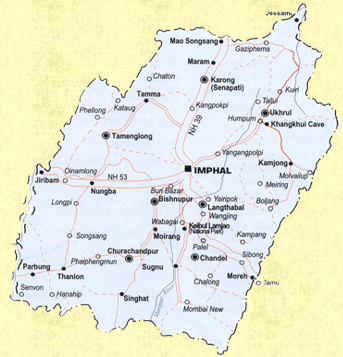|
About Manipur |

|
Manipur
literally means a jeweled land. Manipur is situated in the
northeastern part of India. This town is nestled deep within a
lush green corner of the north east India and surrounded by
blue hills with an oval shaped valley at the centre. Manipur
is bordered in the north by Nagaland, in the east by Myanmar
(Burma), in the south by Mizoram, and in the west by Assam. It
seems much like an exquisite work of art executed by superb
hands of nature and is indeed a state of exquisite natural
beauty and splendors. Manipur is rich in art, culture and
tradition and surcharged with nature's pristine glory. Mrs.
St. Clair Grimwood described it as "a pretty place more
beautiful than many show places of the world" and Late Pandit
Jawaharlal Nehru described it as "Jewel of India". The people
here are very polite and hospitable. The Raasleelas and the
classical dance of Manipur hold a very significant position in
the cultural map of India. The climate of Manipur varies from
the tropical to sub-alpine types. The summer months here are
moderately hot and the winters are comfortable.
|
|
|
|
|
History of Manipur |
|
Manipur was always independent of its neighboring tribal areas.
Manipur was often invaded by Burma, and enjoyed long and stable
governments for a good time. In 1826, Manipur became a part of
British India following the Yandaboo treaty with the East India
Company. This treaty was an agreement at the end of the
Indo-Burmese war that established the sovereignty of the British
government. Manipur came under the British rule as a princely
state after the defeat in the Anglo-Manipuri War of 1891. During
the World War II, the Japanese forces marched to Manipur. After
independence of India in 1947, the princely state of Manipur was
merged in the Indian Union on October 15,1949 and became a
full-fledged state of India on the 21st January, 1972 with a
Legislative Assembly of 60 seats, out of which 20 are reserved
for Scheduled Tribe and 1 is reserved for Scheduled Caste. The
State is represented in the Lok Sabha by two members and by one
member in the Rajya Sabha.
|
|
|
|
|
Festivals
of Manipur |
|
The
festivals of Manipur hold special importance to the people
of the state. Most of their festivals are characterized by
traditional dance and music and refreshment. The Yaosang
festival is celebrated on the full-moon day of March. This
festival is celebrated to welcome the spring season. There
are various other festivals like the Cheirouba, the
Manipuri New Year and Ningol Chakaouba. The festival to
reassure the loving relationship of the siblings is known
as Ningol Chakaouba. Kut is another festival that marks
the harvesting season in Manipur. Feasts, traditional
drinks, and merrymaking are the main characteristics of
the festival. |
 |
|
|
|
|
Places
in Manipur |
|
Manipur has a
lot to offer to the tourists visiting this state. Some of the
tourist attractions in Manipur are the Shree Govindajee Temple
(a pilgrimage as well as historic center of the Vaishnavite),
Kaina (a sacred place of Hindus), Khwairamand Bazaar (a market
place run by women), Manipur Zoological Garden, the beautiful
Loktak Lake and Sendra Island. Besides, Langthabal, Moirang,
Moreh, Phubala, Singda, Khongjom, Sahid Mandir, Khonghampat
Orchidarium, Keibul Lamjao National Park, Sekta Archeological
Living Museum, and the Manipur State Museum are also worth
visiting places in Manipur.
More
Information on Places in Manipur
|
|
|
|
|
Dances of Manipur |
|
 |
The ancient
musical forms of the valley dwellers are closely connected to
the worship of Vishnu which are expressed in the Manipuri
School of Indian Dance. The Rajashree Bhagyachandra created
the famous Ras Lila, the classical dance of Manipur, out
of his enchanting dream by the grace of Lord Krishna. The Rasa
Lila dances that usually adopt a Krishna-Gopi theme are performed at every ceremony. The 'Sankirtanas'
often precede the Rasa. The tribal ritual dances, some of
which are performed by priests in front of deities are very
different and may end in a trance. The various other dances
that last for several days observe a strict form and are accompanied by the drone of a
bowed instrument called the "pana". |
|
|
|
|

